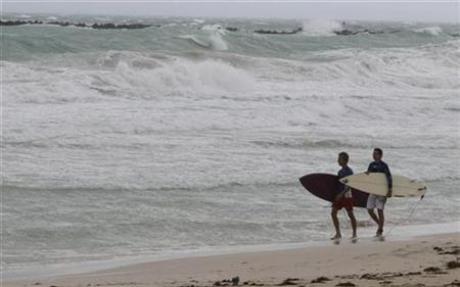Busy 2010 Hurricane Season Ends With U.S. Unscathed
Date: 01-Dec-10
Country: USA
Author: Erwin Seba

Surfers look at the Atlantic Ocean as Tropical Storm Bonnie made
landfall in Miami Beach, Florida, July 23, 2010.
Photo: Reuters/Joe Skipper
The third busiest Atlantic storm season officially drew to end on Tuesday but the U.S. shoreline and its key energy producing hubs were mostly untouched by any of the year's major storms.
Local weather conditions that developed during the season thwarted meteorologists predictions that as many as five storms would strike the U.S. coastline.
"There's no way we could tell that we would see that," said William Gray, who founded Colorado State University's Tropical Meteorology Project.
The 2010 season spawned 19 named storms, tying for the third most active season with 1897 and 1995, according to the U.S. National Hurricane Center. Of those storms, 12 became hurricanes, tying the second highest season in 1969. There were five major hurricanes in 2010.
Most forecasters had predicted between 14 and 21 named storms, eight to 12 of which were expected to be hurricanes, with as many as six of those major hurricanes.
Only one tropical storm, Bonnie, made landfall in the United States, striking south Florida in July.
"We were at the bottom end of the range of impacts on the U.S. coast," said Joe Bastardi, chief long-range meteorologist and hurricane forecaster for Accuweather.com.
On average, 25 percent of storms in a given year are expected to make landfall, Gray said.
"This year it was more like 2 to 3 percent," he said. "We were very lucky."
While the storms missed the United States, they did bring death and destruction to eastern Canada, Bermuda, islands in the Caribbean Sea and Central America.
Deaths attributable to the storms range from 250 to over 1,000 and damage estimates run from $1.5 billion to over $10 billion, according to media reports.
WELCOME BREAK FOR GULF COAST
For the U.S. Gulf Coast oilpatch, the lack of storms in the northern Gulf of Mexico was a welcome break as the summer was spent focusing on the effects from BP Plc's Deepwater Horizon oil platform disaster in April.
Before the flow of oil from the Deepwater Horizon was stopped in mid-July, the disaster threatened to have all the effects of a major hurricane with worries of shutdowns of shipping across the Gulf due to a spreading oil slick.
As it was, the Deepwater Horizon released 4.9 million barrels of crude oil into the Gulf, led to a drilling moratorium and promises of tighter regulation from the Obama Administration.
The breakdown of the Gulf Loop Current prevented the spread of oil across the Gulf and likely played a role in the lack of major storms.
"The Loop Current broke down in the Gulf," said Bastardi. "I don't know if that was due to the extensive rainfall in June and July in the northern Gulf. Rain takes energy out of the system."
The Loop Current circulates warm water from the Yucatan peninsula of Mexico to Cuba, moving Gulf water into the Atlantic.
Also preventing Atlantic storms from reaching the United States was a drop south in the jet stream over North America, according to the U.S. National Hurricane Center.
"We had a jet stream dip which opened up an alley for those storms to follow away from the U.S. coast," said Dennis Feltgen spokesman for the National Hurricane Center.
As for 2011 hurricane season, the earliest forecasts will be issued in December.
While forecasters aren't ready to lay out the expectations, the Atlantic has been in an active hurricane cycle since 1995. The hurricane cycles last between 25 and 40 years.
"We're kind of at the top of the cycle now," said Todd Crawford, chief meterologist at WSI Corp.
(Editing by Marguerita Choy)